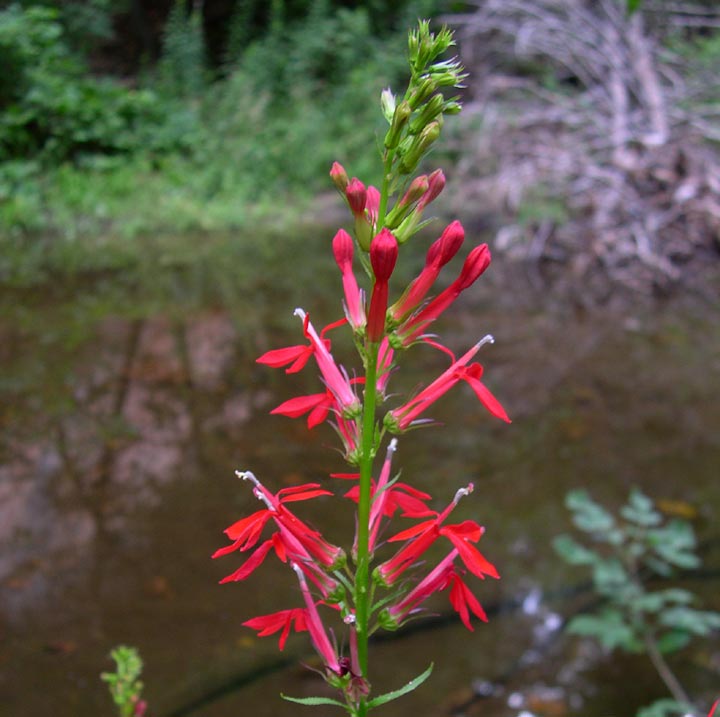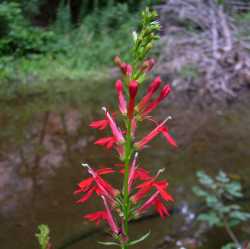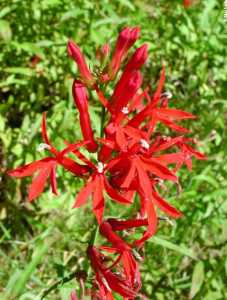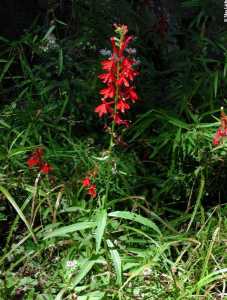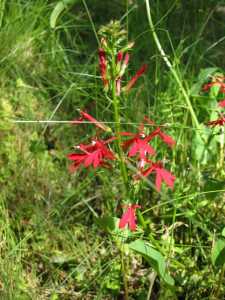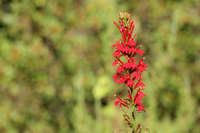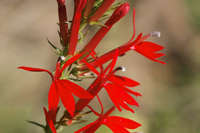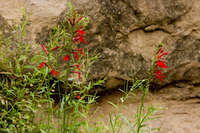Duration: Perennial
Nativity: Native
Lifeform: Forb/Herb
General: Perennial herbs, 30-100 cm tall; stems erect and unbranched, glabrous to pubescent.
Leaves: Alternate, and sessile to short-petioled; blades linear-oblong to ovate-lanceolate, 3-15 cm long and 2-16 mm wide, with pointed tips, the margins lined with small, gland-tipped teeth..
Flowers: Red, in slender spikelike racemes 7-36 cm long, on pedicels 5-15 mm long, each pedicel with a leaflike bract at the base; sepals 5, linear to subulate, 5-10 mm long; corolla red to scarlet, fused into a 2 cm long tube at the base and 2-lipped at the top, with 2 lobes on the upper lip and 3 lobes on the lower lip.
Fruits: Capsule 4-5 mm long by 5-8 mm wide, 10-ribbed and papery; each capsule contains many seeds.
Ecology: Found in moist soils, especially along streams, from 3,000-7,500 ft (914-2286 m); flowers June-October.
Distribution: California east to Quebec and Florida; south to Panama.
Notes: This is such a striking plant it is hard not to notice in flower. Pay attention to the bilabiate corolla, especially how the lower lobes are in threes and the way that they flare out at a right angle to the tube. Distinguish it from red-flowered Penstemons based on the alternate leaves with tiny teeth around the edges (Penstemon spp. always have opposite leaves).
Ethnobotany: Used medicinally to treat headaches, worms, colds, hard to heal sores, fever, stomach trouble, syphilis, typhoid, epilepsy, rheumatism, swelling, and aches and pains; also used as a love medicine.
Etymology: Lobelia is named for Matthias de l'Obel (1538-1616) a Flemish botanist; cardinalis means red.
Synonyms: Lobelia fulgens, L. splendens, L. cardinalis var. graminea, L. cardinalis var. meridionalis, L. cardinalis var. multiflora, L. cardinalis var. phyllostachya, L. cardinalis var. propingua, L. cardinalis var. pseudosplendens
Editor: SBuckley 2010, AHazelton 2017
Perennial herb 0.5 - 1.8 m tall
Stem: erect, unbranched, coarse, usually hairless but possibly slightly hairy.
Leaves: numerous, alternate, nearly stalkless, usually three to five times longer than wide (to 16 cm long and 5 cm wide), typically broadest at or below middle, with pointed tip and toothed edges. The upper surface of the leaves can be hairless or sparsely ascending-hairy the hairs are never in any particular orientation.
Inflorescence: a terminal, erect, leafy-bracted, elongate, 10 - 50 cm tall spike-like cluster of numerous flowers on hairy, 0.5 - 1.5 cm long stalks with two, basal, tiny bracts (bracteoles) just above the subtending, narrow, leaf-like bract.
Flowers: bright or deep red, 3 - 4.5 cm long, slender, bilaterally symmetric, tubular and somewhat two-lipped with two fairly erect strap-like upper lobes and three spreading lobes below. The flowers are actually flipped upside down so that the morphologic upper lip (of three spreading lobes) appears on the bottom of the flower, and the two strap-like lobes at the top of the flower are actually the morphologic lower lip.
Sepals: five, but fused at base into a short cup, then separating into 8 - 12 cm long linear lobes with minuscule (or none) ear-like appendages (auricles) between lobe bases.
Petals: five, but fused into a long, slender, straight tube with slits on each side near base, then separating into five lobes and appearing two-lipped with two rather erect strap-like lobes above and three spreading lobes below. Unlike some other species in the genus, the two-lobed "upper" lip (morphologic lower) has no beard of hairs near the base.
Stamens: five, but fused into a 2.4 - 3.3 cm long tube extending beyond petals. Two anthers are shorter than the other three, and these two are also bearded at the tip.
Pistil: with a two-chambered, inferior ovary; one long style positioned through center of stamen tube; and a two-lobed, often fringed stigma. As the style elongates up through the stamen tube, it pushes the pollen out of the anthers.
Fruit: numerous, two-chambered, many-seeded capsules, which open at top.
Similar species: This is the only red-flowered Lobelia in the Chicago Region. If there is no flowering shoot, L. cardinalis could be confused with L. siphilitica but leaf characteristics distinguish them since the leaves of L. siphilitica are widest at or above the middle, and the upper leaf surfaces are always covered with appressed forward-pointing hairs. When in flower, the two species are unmistakable since L. siphilitica has relatively bulky blue or white flowers and L. cardinalis always has slender bright red flowers.
Flowering: July to early October
Habitat and ecology: Commonly found in wet soil and shaded shallow water, especially in ditches. This species is particularly common in the Kankakee River Valley area in the southern tier of Chicago Region counties such as Kankakee County, Illinois and Newton and Jasper Counties in Indiana.
Occurence in the Chicago region: native
Notes: Lobelia cardinalis is normally pollinated by hummingbirds. A hybrid, L. x speciosa, can be produced between L. cardinalis and L. siphilitica although these rarely occur in nature due to pollinator differences (the latter species is pollinated by bees). The occurrence of this hybrid may suggest a close relationship between the two parent species. For more information, see Bowden 1982.
Author: The Field Museum
Infrequent throughout the state in low ground in woods, along ditches, and on the borders of lakes and ponds.
Erect, usually unbranched, 5-15 dm, ±hairy or largely glabrous; lvs thin, lanceolate to oblong, to 16 נ5 cm, acute or acuminate, dentate, mostly 3-5 times as long as wide, the lower short-petioled, the upper smaller, sessile or nearly so; racemes 1-4 dm; bracts linear or narrowly lanceolate; pedicels hairy, 5-15 mm, bibracteolate at base; fls 3-4.5 cm, scarlet (rarely pink to white), the lower lip glabrous within; sep linear, 8-12 mm; auricles none or minute; 2n=14. Wet soil; N.B. to Minn., s. to the Gulf of Mexico. July-Sept. Our plants, as described above, are var. cardinalis.
Gleason, Henry A. & Cronquist, Arthur J. 1991. Manual of vascular plants of northeastern United States and adjacent Canada. lxxv + 910 pp.
©The New York Botanical Garden. All rights reserved. Used by permission.


